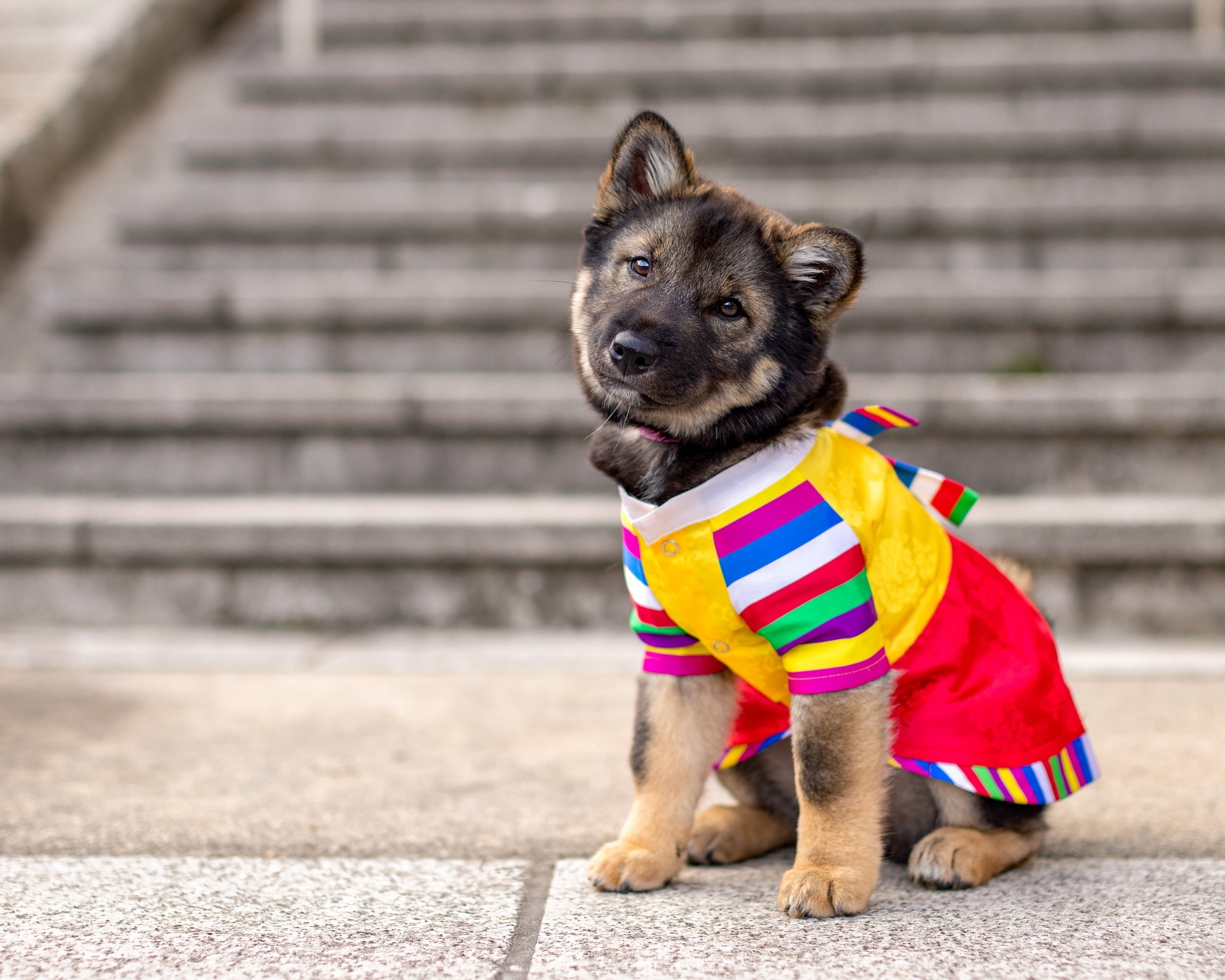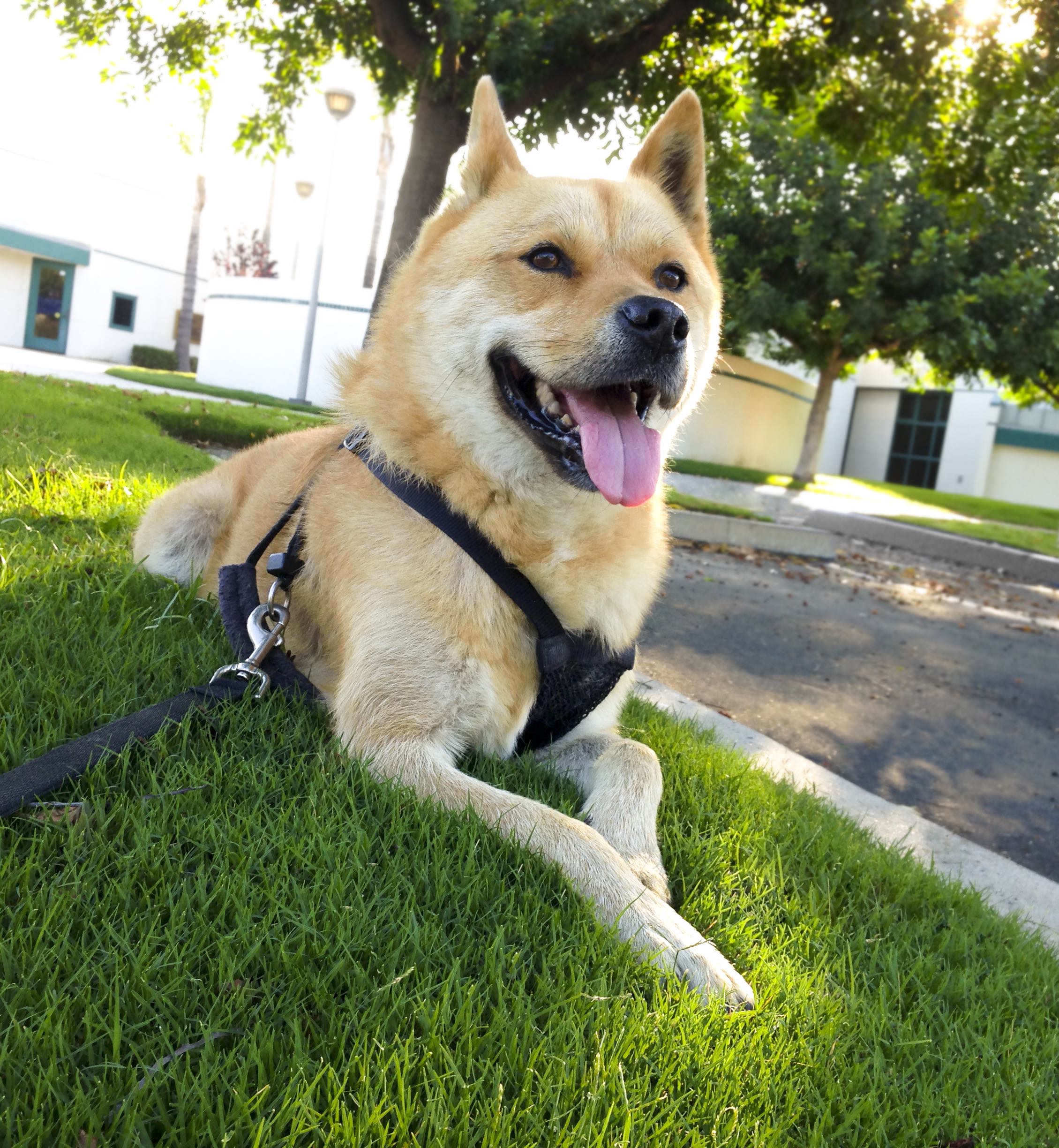Jindo
All dogs are treasures, but the loyal and dignified Korean Jindo is a designated national treasure in its country of origin. Despite this honor, little is known about the breed’s beginnings. There’s no written record of the Jindo’s inception, but it’s widely assumed that the breed has been roaming Jindo, an island off South Korea’s southwest coast, for thousands of years.
At 30–50 pounds, Jindos are medium-sized dogs with a foxlike face and a thick tail that curls up over their coarse, medium-length double coat. Their fur typically comes in shades of red, white, gray, black, or tan. Muscular and agile, Korean Jindo dogs are known for being athletic.
A hunter by nature, the Jindo is intelligent, bold, and reserved. Sometimes described as one-person dogs, Korean Jindos are unwaveringly devoted to their humans and can make wonderful pets with proper socialization and training. Prospective pet parents should ensure they can provide a Jindo with the home they need to thrive.
Caring for a Jindo
Hunting and sporting breeds, such as the Jindo, have strong prey drives that can go beyond play. Teaching them to come when called can help decrease the risk of them chasing smaller animals. They can also be wary of strangers without proper socialization.
The Korean Jindo Association of America (KJAA) notes that the intelligent and driven Jindo tends to wander from their home. Again, behavior modification and training for recall can help curb this behavior.
The Jindo’s temperament makes them prone to anxiety, which can make traveling and meeting new people stressful for them. Socializing your Jindo puppy early and sticking to a daily routine can help combat this issue.
Jindos keep themselves very clean, shed moderately, and can usually get by on being brushed once or twice a week. Unlikely to be content with a couple of short walks a day, the breed does best when they can join active families who spend a lot of time outdoors and are committed to exercising their dog—mentally as well as physically.
Shop for Your Breed
- Optixcare Dog & Cat Eye Cleaning Wipes, 50 count$11.98Chewy Price
- Virbac Epi-Otic Advanced Ear Cleaner for Dogs & Cats, 4-fl oz bottle$12.34Chewy Price
- Virbac C.E.T. VeggieDent Fr3sh Dental Chews for Medium Dogs, 30 Count$31.79Chewy Price
- FURminator Short Hair Dog Deshedding Tool, Blue, Large$35.25Chewy Price
Jindo Health Issues
The Jindo is a generally healthy breed with a lifespan of 14–15 years. Still, like all dogs, there are some health conditions these Korean dogs are prone to developing. The KJAA notes that the following two issues have been discovered in the breed in the United States:
Discoid Lupus Erythematosus
Lupus is an immune-mediated disease in which a dog’s immune system attacks its own DNA. Discoid lupus erythematosus (also called DLE, nasal solar dermatitis, and collie nose) is a form of lupus that is far less aggressive than systemic lupus because it affects only the skin—specifically that of the nose and face. Sunlight avoidance and medication can help manage the disease.
Signs of DLE include:
-
Loss of nose pigment (black turns to gray or pink)
-
Scaling and cracking of nose skin
-
Sores on the nose, ears, or inside the mouth
-
Sores that worsen when exposed to sunlight
Hypothyroidism
Hypothyroidism describes when a dog’s thyroid glands aren’t producing enough thyroid hormones, which serve an important function in metabolism. This hormone deficiency affects the functioning of all organ systems, and treatment typically requires lifelong hormone replacement therapy with oral medication.
Most signs of hypothyroidism are related to their decreased metabolism and include:
-
Unexplained weight gain
-
Inability to stay warm
-
Mental dullness
What To Feed a Jindo

Every dog is unique, so there’s no one-size-fits-all recommendation for feeding your Korean Jindo dog. Instead, you’ll want to work with your veterinarian to develop a feeding plan that’s nutritionally complete and balanced for your pup’s age, weight, and health.
How To Feed a Jindo
Most adult Jindo dogs should eat two meals a day: once in the morning and again in the evening. Because Jindo puppies have a higher metabolism than adult dogs, it’s generally best to add a midday feeding for a total of three meals. Your vet can help you determine the best feeding schedule for your dog’s age.
How Much Should You Feed a Jindo?
The nutrition label on your dog’s food bag includes a feeding guide that will give you a general idea of how much you should feed your Korean Jindo based on their weight. But for a more precise answer, ask your veterinarian. In addition to your dog’s weight, they will consider their age, body condition score, lifestyle, and health needs.
Nutritional Tips for Jindo Dogs
If your Jindo is eating a complete and balanced diet of dog food approved by the Association of American Feed Control Officials (AAFCO), they shouldn’t need anything extra.
However, nutritional supplements and even prescription diets are sometimes used to treat or prevent certain health conditions. Talk to your veterinary team before adding anything new to your Jindo’s diet.
Behavior and Training Tips for Jindo Dogs
Jindo Personality and Temperament

Jindo dogs are alert, courageous, and loyal companions. When appropriately socialized, they can do well with other pets and children, but some may prefer to be the only pet at home. Working with a certified trainer can help your Jindo be more comfortable and less anxious around new people and animals.
Jindos are active, intelligent dogs that need regular exercise and interaction, but their desire to explore new territories, coupled with their notorious escape artist abilities, underscore how important it is to keep them safely on a leash or inside a fenced-in yard at all times. Neutering your dog can also help decrease the risk of wandering.
Jindo Behavior
Because they are highly intelligent, Jindos are highly susceptible to anxiety—especially separation anxiety. Jindos should not be left alone for long periods. Bored, anxious Jindo dogs may use their smarts to escape or may exhibit unwanted behaviors like barking and chewing. Work with your veterinarian to learn how to help a dog with social anxiety.
The Jindo’s wariness of strangers means they need thoughtful, patient pet parents who can help their dog properly prepare for potentially stressful situations like staying at a new kennel or meeting a new pet sitter.
Jindo Training
All dogs go through a critical development period from birth to around 16 weeks of age. During this time, they learn how to interact with humans and other animals. Talk to your Jindo breeder about how they approach socialization, as this is an incredibly important part of caring for a dog the KJAA describes as “inherently suspicious.” Properly socialized Jindos are more likely to be able to peacefully coexist with other animals in the home and on neutral territory, like the park.
Although Jindos are exceptionally smart, that doesn’t mean they’re easy to train. Regardless of how independent-minded your dog is, consistent positive training that uses rewards instead of punishment is the best way to teach your pup while building the human-animal bond.
Because Jindos bond so deeply with their humans, the KJAA recommends that pet parents be the trainer instead of handing the job over to someone else (though this doesn’t mean that you can’t receive help from a professional trainer). The training process is also a great way to provide Jindo dogs with the mental and physical exercise they need.
Fun Activities for Jindo Dogs
-
Obedience training
-
Skills training
Jindo Grooming Guide
As descendants of wild dogs, Jindos are predictably low-maintenance. They’re known for their cleanliness, and their dense double coat needs attention only once or twice a week. Most days, their shedding could be described as “moderate.” However, twice a year they lose their undercoat and need extra brushing.
Skin Care
Korean Jindos don’t require special skin care. However, be sure to check their skin for ticks after outdoor play.
Coat Care
The Jindo’s thick, coarse fur needs to be brushed once or twice a week. The frequency may need to be increased during the two times a year they lose their undercoat.
Eye Care
There aren’t any known eye issues that commonly affect Jindos. Call your vet if you notice anything out of the ordinary, such as redness or discharge.
Ear Care
Talk to your veterinary team about how and how often you should clean your Jindo’s ears, and make an appointment if you notice any signs of infection (such as head-shaking, redness, pain, or a foul odor).
Considerations for Pet Parents
Here are some questions to consider before adding a Korean Jindo dog to your family:
-
Am I an experienced pet parent with the skills and patience necessary to train a dog using positive reinforcement?
-
Do I have the time and patience to help a reserved dog adapt to new environments and people, such as kennels and pet sitters?
-
Do I have time to provide a dog with mental and physical exercise every day?
-
When outside, can I keep a dog either on a leash or within a securely fenced area?
-
Can I give a dog daily companionship?
-
Am I financially prepared to provide veterinary care?
-
Can I provide a dog with a loving home for their lifetime, which could be 15 years or more?
If you can answer these questions with an enthusiastic “Yes!” you may be ready to parent a Jindo.
Jindo FAQs
Is a Jindo a good family dog?
Jindos are smart, dignified, devoted dogs, but they aren’t the best choice for all families. They tend to do best in active families who are experienced dog parents.
Are Jindos cuddly?
Jindos love their humans and enjoy being active with them, but they aren’t known for being particularly cuddly and affectionate. They’re more likely to enjoy hiking with you than watching TV on the couch.
Do Jindo dogs bark a lot?
Any dog can bark a lot—more than breed, training and socialization affect how much a dog barks. Like other dogs, Jindos may bark to alert their family, but they are not known to be excessively vocal.
What’s the difference between a Jindo and a Shiba Inu?
The Shiba Inu and the Jindo may look similar, but they are very different dogs. While Jindos originated in South Korea, Shibas hail from Japan. Shibas are also smaller (17–23 pounds vs. 30–50 pounds) and tend to be more accepting of other animals and new people than Jindos.
Featured Image: Natasha Brown/iStock / Getty Images Plus via Getty Images




